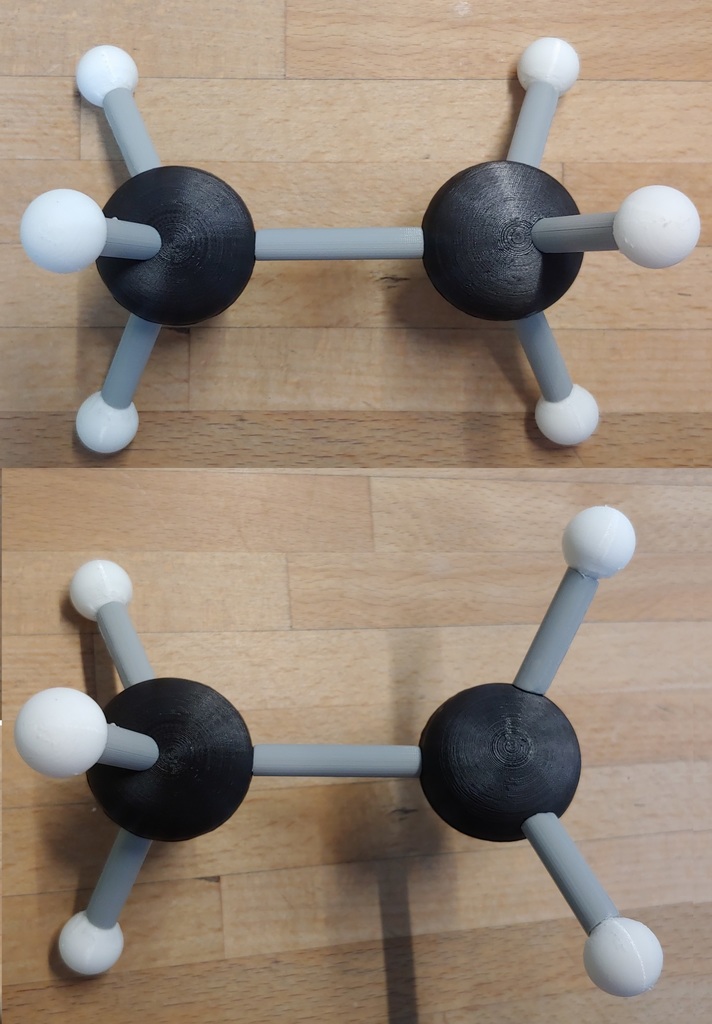
Ethane model (Ethan)
thingiverse
Scroll Down for english Ethan-Modell Zum Verständnis des Unterschieds zwischen gesättigten und ungesättigten Kohlenwasserstoffen fehlt es manchen Schülerinnen und Schülern an räumlichen Vorstellungsvermögen über die Molekülgeometrie. Das vorliegende Modell versucht daher, die Besonderheiten des Ethan-Moleküls zu visualisieren:Einerseits die Gleichförmigkeit der Bindungswinkel, andererseits die Möglichkeit der Kohlenstoffatome entlang der C-C-Bindungsachse samt Substituenten zu rotieren. Im gleichen Maßstab finden Sie von mir auch Ethen, Ethin und Benzol auf Thingiverse, so dass die vieri Verbindungen hinsichtlich ihrer Struktur gut verglichen werden können. Aufgrund ihrer Größe eignen sich die Modelle auch zur Demonstration. Das Modell ist maßstabsgetreu. Vorausgesetzte Daten --> umgesetzt im Modell zu Bindungslängen C-C-Bindungslänge 154 pm --> 77 mm C-H-Bindungslänge 109 pm --> 54,5 mm HCH-Bindungswinkel 109,5 --> 109,5° Kovalenzradien Kohlenstoff 76 pm --> 38 mm Wasserstoff 32 pm --> 16 mm Anleitung: Da viele 3D-Drucker nicht genau maßhaltig sind, habe ich bei den Bauteilen Toleranzen eingeplant. Wenn Ihr Drucker sehr genau druckt, können die Teile beim Zusammenstecken wacklig sein. Generell sollten aber (die meisten) Teile miteinander verklebt werden. Dann wackelt auch nichts mehr. Drucken Sie Ethan_Carbon 2x mit 0.1mm Schichtdicke in schwarz Ethan_CC-Bond 1x mit 0.1mm Schichtdicke in grau Ethan_ Links 1x mit 0.1mm Schichtdicke in grau Ethan_CH-Bond 6x mit 0.1mm Schichtdicke in grau Ethan_Hydrogen 6x mit 0.1mm Schichtdicke in weiß Verkleben Sie C-H-Bindungen, Wasserstoffatome und Stifte zunächst wie auf Abb.1. Durch die Form der Stifte können die Bindungen nicht falsch angebracht werden. Damit die C-C-Bindungsachse als Rotationsachse funktionieren kann, musste jedes Kohlenstoffatom in zwei Teilen gedruckt werden. Verkleben Sie zunächst in je eine Hälfte die beiden kleinen Zylinder und legen dann die Bindung in die Aussparung in die Hälfte eines jeden Kohlenstoffatoms. Kleben Sie nun die jeweils andere Hälfte auf, aber achten Sie darauf, dass kein Klebstoff an die Bindung kommt. (Abb. 2) Die beiden Kohlenstoffatome sollten nun gegeneinander verdrehbar sein. Die Aussparungen für die Bindung sind sehr großzügig angelegt. Die Atomhälften können daher ohne Supports gedruckt werden. Leider sitzt so die Bindung nicht ganz fest, aber in der Wirklichkeit ist sie ja auch nicht so starr. Verkleben Sie dann die C-H-Bindungen mit den Kohlenstoffatomen (Abb. 3). Ethane model To understand the difference between saturated and unsaturated hydrocarbons, some students lack the spatial imagination of molecular geometry. The present model therefore tries to visualize the peculiarities of the ethane molecule: On the one hand the uniformity of the bond angles, on the other hand the possibility of the carbon atoms rotating along the C-C bond axis including the substituents. On the same scale you will also find ethene (ethylene), ethine (acetylene) and benzene from me on Thingiverse, so that the four compounds can be easily compared with regard to their structure. Due to their size, the models are also suitable for demonstration. Assumed data --> implemented in the model to Bond lengths C-C bond length 154 pm --> 77 mm C-H bond length 109 pm --> 54,5 mm HCH bond angle 109,5 ° --> 109,5 ° Covalent radii Carbon 76 pm --> 38 mm Hydrogen 32 pm -->16 mm Instructions: Since many 3D printers are not exactly dimensionally accurate, I have planned tolerances for the components. If your printer prints very accurately, the parts can be wobbly when you put them together. In general, however, (most) parts should be glued together. Then nothing wobbles either. Print Ethan_Carbon 2x with 0.1mm layer thickness in black Ethan_CC-Bond 1x with 0.1mm layer thickness in gray Ethane_ Links 1x with 0.1mm layer thickness in gray Ethan_CH-Bond 6x with 0.1mm layer thickness in gray Ethan_Hydrogen 6x with 0.1mm layer thickness in white First glue the C-H bonds, hydrogen atoms and pins as shown in Figure 1. The shape of the pins prevents the bonds from being incorrectly attached. In order for the C-C bond axis to function as an axis of rotation, each carbon atom had to be printed in two parts. First glue the two small cylinders in half and then place the bond in the recess in half of each carbon atom. Now glue the other half on but be careful not to get any glue on the bond. (Fig. 2) The two carbon atoms should now be rotatable against each other. The cut-outs for the bond are very generous. The atom halves can therefore be printed without supports. Unfortunately, the bond is not that tight, but in reality it is not that rigid either. Then glue the C-H bonds to the carbon atoms (Fig. 3).
With this file you will be able to print Ethane model (Ethan) with your 3D printer. Click on the button and save the file on your computer to work, edit or customize your design. You can also find more 3D designs for printers on Ethane model (Ethan).
